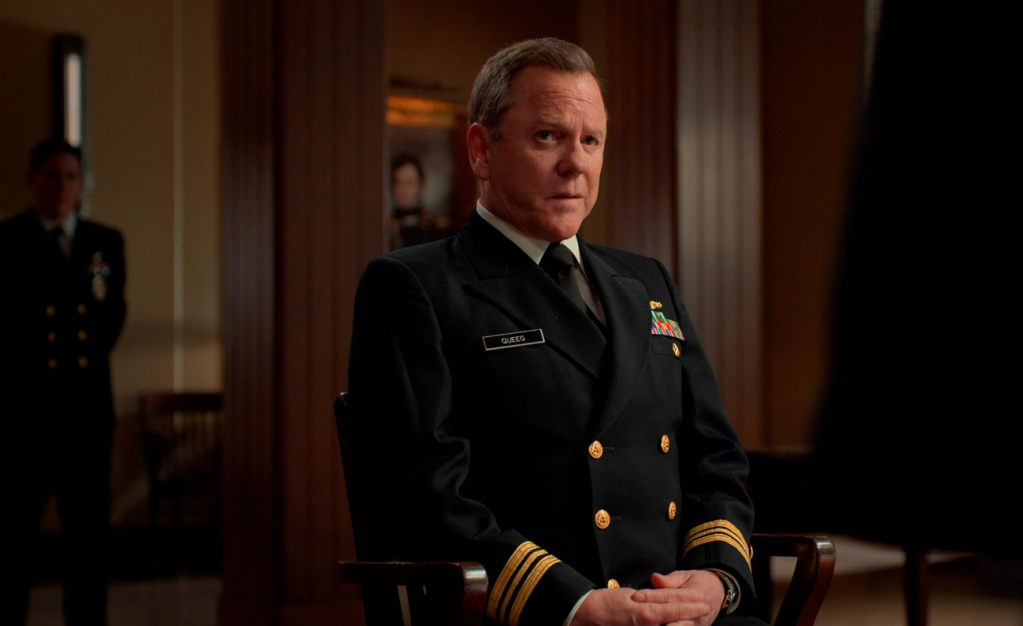
In his final feature as a director, William Friedkin’s career comes full circle as he goes back to his television roots and crafts a solid, well-acted, old-fashioned entertainment. Similar to the programs Friedkin helmed in the late 1950s and early 1960s, The Caine Mutiny Court-Martial, based on Herman Wouk’s adaptation for the stage from his own novel, begins slowly and very talky, but once you settle into the rhythm of the dialogue and the situation at hand, it becomes rather engrossing. Like so much of Friedkin’s work, the main theme is the thin line between good and evil, or in this case the thin line between capability and incompetency. The central question: is Lt. Commander Queeg (Kiefer Sutherland), captain of the USS Caine, a misunderstood and brave Naval officer whose subordinates reject his traditional methods, or is he a paranoid and unruly man whose personal demons put the crew and ship in unnecessary danger?
Given Friedkin’s constant admiration for movies and figures of the Classical Hollywood period, it is fitting that he would update Wouk’s play for the twenty-first century, but in a style more akin to how Wouk and others would have understood the military and Navy as a whole. Some have commented that this adaptation is not reflective of the Navy in its current form, and it is jarring at first to watch the movie begin in the tribunal courtroom, then methodically build its story solely around eyewitness and expert testimony delivered on the stand. With the exception of a prologue and epilogue, the entire film takes place inside the courtroom. No flashbacks or subsequent information is given to ‘fill in the gaps.’ This becomes the responsibility of the viewer as we are forced, a la Rashomon, to decipher who is telling the truth and even if such a question can be answered. Undoubtedly, adaptations from other directors would have included scenes depicting the character’s experiences and points of view as a way to make the dense plot more accessible. Yet, Friedkin believes so strongly in the weight of the material that he trusts the viewer to follow along and keep track of all the characters and their conflicting viewpoints. Similar to his 1997 TV adaptation of 12 Angry Men, Friedkin uses no flashy gimmicks or dynamic visual tricks to distract. The tension and drama reside in the subtle changes of the characters’ testimonies, the smooth and unobtrusive editing and how all the intricate pieces fit together in this tightly woven story of corruption and instability.

Like his collaborations with playwright Tracy Letts, Friedkin relies heavily on his cast to bring to life the plot, characters and moods of these specific periods. In this case, some casting choices seem odd but eventually come round to be fully acceptable. Sutherland, something of an odd choice to play the role Humphrey Bogart immortalized in the 1954 adaptation, is made up to look years older and has a unique speech affect. Yet, through his brief but powerful appearances, he captures the indignation and tragedy of a man whose methods of leadership have fallen out of step with the modern Navy and his realization that his storied career will come crumbling down as a result. Perhaps the best performance is from Jason Clarke as the defense attorney Greenwald, whose open contempt toward the trial and his client makes for a very interesting angle: why does he continue to defend his client using such unconventional methods that almost aggressively extract all the facts from witnesses? Clarke is precise but listens enough to understand everyone’s motivations, and his clarity in the epilogue puts everything into perspective. His client, Lt. Maryk (Jake Lacy), is young, eager and naive but there is more to him than meets the eye and this becomes clearer as we discover his relationship with fellow Lieutenant Keefer (Lewis Pullman), whose own role reveals the hidden layers of this story.

Other supporting roles from Lance Reddick as the chief tribunal and Jay Duplass as an expert witness give specific weight to this case, which ponders if it is ever acceptable for a lieutenant to override the orders of his superior in the name of safety for the crew and ship. In some ways, this element shows the age of Wouk’s work as it is more interested in the chain of command than an individual sailor’s safety and well-being, buzzwords which have become all-encompassing in today’s society. Yet, Friedkin stays true to the tone and philosophy of the original work, which presupposes ideas like loyalty, meritocracy and the importance of respecting authority, even if it goes awry. This is not to say Friedkin was sending a message to today’s audiences with this final feature, but it illustrates his ability to find the inherent drama in any story and focus on the emotions and conflicts that drive our interest in something even as apparently dry as a mutiny on a Navy ship (which we never see!). Friedkin was one of the masters of tension in cinema, and he proved it right up to the very end. The movie’s final shot gives the story a sudden but satisfactory conclusion and illustrates the essence of William Friedkin: when you strongly believe in something, never back down. Better to be admired for your steadfastness than your volatility.
Leave a comment